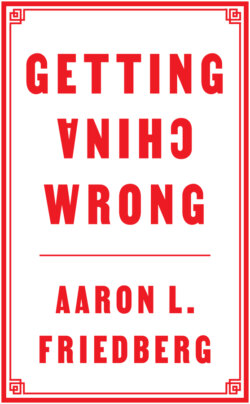Getting China Wrong

Реклама. ООО «ЛитРес», ИНН: 7719571260.
Оглавление
Aaron L. Friedberg. Getting China Wrong
CONTENTS
List of Illustrations
List of Box
List of Map
Guide
Pages
Praise for Aaron Friedberg
Dedication
GETTING CHINA WRONG
Preface
Acknowledgements
Introduction
Notes
1 The Origins of Engagement
Engagement 2.0
Ideology: the American vision of a liberal international order
Material trends: democratization, marketization, globalization
Interests and influence
Notes
2 Rationales and Expectations
Geopolitics: from quasi-ally to “responsible stakeholder”
Economics: “markets over Mao”22
Politics: China’s “short march” to democracy
Conclusion
Notes
3 Politics: “The Party Leads Everything”
Lenin’s legacy
The Party’s evolving strategy for survival
Was democracy ever possible?
The lingering trauma of Tiananmen
“Consultative Leninism” and the search for a “Harmonious Society”
The demise of “soft authoritarianism”
The totalitarian turn
“Xi Jinping Thought,” pseudo-Confucianism, and the birth of the “China Dream”
BOX 3.1 “Communiqué on the Current State of the Ideological Sphere”
Seven “false ideological trends, positions, and activities”:
Four responses:
Conclusion
Notes
4 Economics: “A Bird in a Cage”
“Mercantilist Leninism”3
The Party’s evolving strategy for growth
Deng crosses the river
Jiang engineers a miracle
Zhu Rongji and the transition illusion
Hu at the crossroads
“Indigenous innovation”
Xi recasts the cage
Seizing the “commanding heights”
“Dual circulation”
Conclusion
Notes
5 Strategy: “The Great Rejuvenation of the Chinese Nation”
The roots of revisionism
The Party’s evolving strategy for achieving regional preponderance and global power
“Hide and bide” Attending to the “main task”
Escaping encirclement
Two crises
“Get some things done” The post-9/11 “period of strategic opportunity”
The global financial crisis and the shift towards greater assertiveness
“Strive for achievement” Pushing for regional preponderance
Challenging America’s global hegemony
A grand strategy for a “new era”
Conclusion
Notes
6 Getting China Right
The failure of engagement. Did engagement fail?
“There was no alternative”
Is Xi to blame?
Why did it take so long to acknowledge the failure of engagement?
The lexicon of strategic paralysis
Objectives
Objections
Mobilization
Partial disengagement43
Counterbalancing
Waging “discursive struggle”
Conclusion
Notes
Index
A
B
C
D
E
F
G
H
I
J
K
L
M
N
O
P
Q
R
S
T
U
V
W
X
Y
Z
POLITY END USER LICENSE AGREEMENT
Отрывок из книги
“A decade ago, Aaron Friedberg courted unpopularity with A Contest for Supremacy, a book anticipating the imminent failure of engaging China at any price. His warnings were demonstrably worth heeding. Now in Getting China Wrong he makes the case that the United States and other democracies still underestimate the struggle ahead. But this is no counsel of despair: instead, Friedberg articulates a multi-layered action agenda, arguing that the best form of defense could well involve a willingness to impose costs.”
Rory Medcalf, Head of the National Security College,
.....
Lake’s bumper-sticker summary of America’s new grand strategy never gained the same currency as George Kennan’s notion of “containment,” but it was apt nonetheless. As the post-Cold War era began, the United States set its sights on expanding the scope of what had been a partial, geographically constrained liberal order to include the entire world and, in particular, the swath of Eurasia that extended from Eastern Europe, across the newly independent republics of the former Soviet Union, to China. Here the aim was to “help democracy and market economics take root” where they had not already done so, and to “foster and consolidate” new liberal regimes when they did begin to blossom.33
In dealing with the nations that had arisen out of the wreckage of the Soviet empire in Eastern Europe, the United States and its allies used the promise of incorporation into Western political institutions and the global economy as a tool for encouraging liberal reforms. The states that eventually earned full membership in this way were, at the outset, weak, poor, and, for the most part, eager to change. More challenging and, in the long run, more important were Russia and, above all, China. Lacking sufficient leverage to compel their transformation, the democracies effectively inverted the strategy they had used to such good effect along the periphery of the former Soviet empire. Rather than hold out the possibility of inclusion as an inducement to liberalization, the United States and its allies worked instead to bring Russia and China as fully as possible into the existing order and, in particular, into the open global economy, in the hopes that doing so would help speed their domestic economic, political, and social transformation. Instead of change followed by inclusion, the formula was reversed to inclusion followed by change.
.....